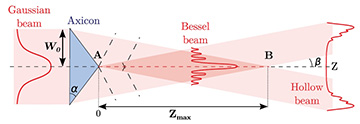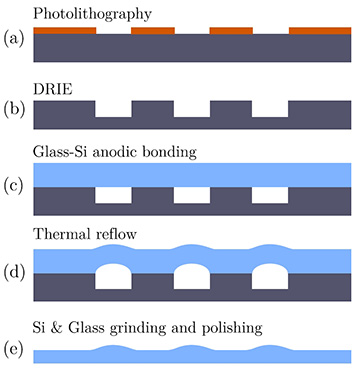![]()
A wafer showing a line of micro-axicons created using the glass-blowing method demonstrated by a team at FEMTO-ST Institute, France. [Image: Nicolas Passilly, FEMTO-ST Institute]
For half a century, optical scientists and engineers have used the cone-shaped lenses known as axicons to convert ordinary Gaussian light beams into structured Bessel beams, useful in applications ranging from laser drilling to metrology to optical trapping. But microfabricating axicons in glass for a new generation of miniaturized optical applications has proved an expensive proposition. And many proposed alternative approaches, while more cost-effective, can produce only non-glass, polymer axicons—tiny plastic lenses that can’t stand up to uses involving high-power lasers.
A research team in France has now come up with a different microfabrication approach that could make it a lot cheaper to create robust, millimeter-scale axicons in glass (Opt. Lett., doi: 10.1364/OL.44.003282). To do so, they drew on some of the same principles used in the ancient art of glass blowing.
Creating structured beams
Bessel beams are beams whose profile includes a high-intensity maximum at the center, surrounded by a series of concentric rings of light. Making a true Bessel beam would require infinite energy—not something readily at hand in the laboratory. But researchers have been able to construct good approximations of Bessel beams by illuminating axicons with ordinary Gaussian beams; the conical structures convert the incoming collimated light into a ring-shaped distribution that mimics the structure of the Bessel beam.

Schematic diagram of Bessel-like beam created by an axicon. [Image: J.V. Carrión et al., Opt. Lett., doi: 10.1364/OL.44.003282 (2019)]
When created by an axicon, a Bessel-like beam of concentric rings is formed in the so-called nondiffracting zone in the near field. Beyond that zone, in the far field, this structure morphs into a single annular ring of light. The nondiffracting near-field beam has potential applications in alignment and metrology, optical trapping, optical coherence tomography (OCT) and a number of other areas; the far-field “hollow beam” holds potential interest in some laser-drilling applications.
Tough to microfabricate
The headache comes when one tries to make these unusual cone-shaped lenses. Larger axicons are made one at a time through diamond turning or grinding and polishing of glass or epoxy. For smaller, millimeter-scale versions that might make their way into handheld scanners or other miniaturized devices, a variety of techniques including electron-beam lithography, direct laser writing, chemical etching and femtosecond laser ablation have been tried.
Some of these techniques work only for creating plastic axicons, which are insufficiently robust for high-intensity applications. And those methods that can create micro-axicons out of glass tend to be more expensive, with some encountering challenges in attaining a sufficiently high surface quality.
Puffing out microlenses at scale

Steps in glass-blowing method for creating micro-optical components (DRIE: deep reactive ion etching). [Image: J.V. Carrión et al., Opt. Lett., doi: 10.1364/OL.44.003282 (2019)]
The research team at the FEMTO-ST Institute, France, led by Nicolas Passilly, wanted to get to an approach that would enable cheaper production of high-quality axicons at scale, for applications such as miniaturized biomedical-imaging systems. The group’s technique begins with a half-millimeter-thick silicon wafer, into which the researchers use standard photolithography methods to etch circular cavities. Next, the pitted wafer is bonded to another half-millimeter-thick wafer of glass.
The glass-covered wafer is then placed in an oxidation furnace and the temperature is cranked up. As the heat lowers the viscosity of the glass, making it more plastic, the rising temperature causes the gas in the pits below the glass layer to expand. The expanding gas, like the action of a diminutive glass blower, puffs out the glass above the circular pits, creating an arched lenslike configuration. The glass is then cooled, ground and polished to create the finished lenses.
From convex to conical
Used with circular pits, this method would be expected to form ordinary convex micro-lenses—and, indeed, it has been used previously to do just that. But Pasilly’s team found that, by replacing a single, circular etched pit with a set of tiny, concentric etched rings, it could tweak the final profile of the blown-glass microlenses to approximate the conical cross-section of a micro-axicon.
The team used this micro-glass-blowing method to create glass axicons with diameters of 0.9 and 1.8 mm. Measurements of the resulting cone-like lenses revealed that the sides were nearly flat. The profile was not precisely conical, owing to some rounding at the tip—an attribute that’s “very common for manufactured axicons,” according to the researchers. Optical tests using a 633-nm He–Ne laser showed that the axicons produced Bessel-like beam profiles in good agreement with numerical predictions.
One particular advantage of the technique, the team believes, is that it “only involves standard microelectromechanical-system (MEMS) fabrication processes,” without the action of direct cutting tools or etching to potentially compromise surface quality. In a press release accompanying the research, Pasilly suggested that the technique was sufficiently general to “be applied to create other shapes, even ones without cylindrical symmetry.” The researchers hope to incorporate their axicons into miniature medical-imaging devices.
